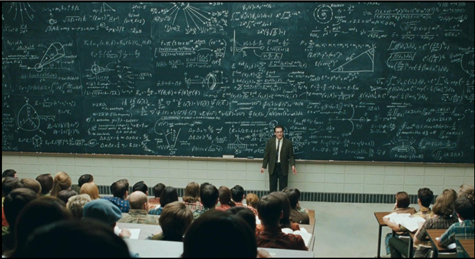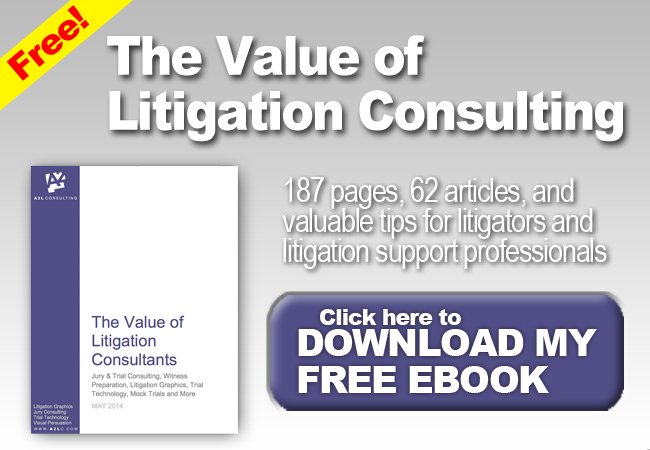by Ken Lopez
Founder/CEO
A2L Consulting
As I mentioned in my article about the value of litigation consulting earlier this week, studies offering guidance on the best ways to persuade in the courtroom are released almost daily. Most are not courtroom-focused studies per se. Instead, they focus on topics like how best to educate, how best to use visual aids, and how best to influence decision-makers.
Virtually all litigators have made it over the hurdle of whether to use litigation graphics at trial - almost all now do. The challenge now is how to use litigation graphics and demonstrative evidence most effectively - and learning how is getting harder, not easier. Like a lot of things, the more you understand the subject, the more complex you realize it is.
At A2L, we advocate strongly for the use of science-proven methods of persuasion in the courtroom. Many of these methods are counterintuitive, like the technique for overcoming confirmation bias by using a hard-to-read font. Many techniques make more obvious sense, like the avoidance of bullet points.
I noticed an education-sector study released last month that proves how bad lecture-only courses are for learning. The traditional expert-exposition method is simply the worst method one can use for education when compared to more active learning methods like small group exercises. As one Harvard professor commenting on the study in the ScienceInsider noted, "the impression I get is that it’s almost unethical to be lecturing if you have this data."
I concur, and I believe there are lessons for the courtroom as well.
Of course, we can't engage our jurors in a thoughtful Q&A session during trial, but what can we do is use scientifically-validated education methods to beat out our opponents. Here are five takeaways based on this and other educational studies that you can apply in the courtroom.
- Switch Your Methods Often: I sometimes say, mix your media to get the point across. I sometimes say you need to use surprise to your advantage in the courtroom. The overarching point here is change, visual or otherwise, drives attention, and you need attention to persuade. Switch up your presentation methodology often.
- Have Your Expert Interact With Your Judge or Jury: Whether it is by using a scale model that an expert can hand to the jury or whether it is by using a trial board that an expert can stand up an interact with, find a way to let them get more involved with your decision-makers. Just remember to prepare your expert witnesses thoroughly. Here's a recorded webinar that covers this topic too.
- Remember a Jury Trial IS a Small Group Exercise: The study referenced above points to how well small group exercises are for learning in a classroom setting. A trial might seem like a lecture since your "students" can't really interact. However, at the end of your "lecture," jurors actually do have to work together (deliberate) to solve a problem. So give them all the tools they need to do that - this includes very clear guidance on damages, a discussion of the verdict form and a suggestion of how to structure their deliberations that favors your positions.
- Lead Them There - Don't Just Lecture: As this study suggests, if all you do is lecture, you are going to lose your jury. So, inject some storytelling in your opening and closing statements and create a path that inevitably leads the jury to the right conclusion. Give them all the tools they will need in the classroom's lab exercise (a.k.a. deliberations) like demonstratives that can be taken into jury room.
- Show Them - Don't Just Tell Them: As one of the original litigation graphics consulting firms, A2L was, of course, founded on this principle. Good science now shows just how important litigation graphics are to a successful case outcome. You must practice continuous learning if you are going to be effective. Here is a good webinar on using PowerPoint litigation graphics successfully, taught by the top visual persuasion consultant at A2L who happens to have also tried complex cases for more than a dozen years.
These related A2L articles will also help you learn more about persuading with litigation graphics, about the science behind courtroom persuasion and about how to keep a jury engaged:
- 6 Studies That Support Litigation Graphics in Courtroom Presentations
- Don't Use PowerPoint as a Crutch in Trial or Anywhere
- 12 Ways to SUCCESSFULLY Combine Oral and Visual Presentations
- Free E-Book Download: Using Litigation Graphics to Persuade and Win
- Free Webinar - Watch Now: Storytelling in Litigation
- 6 Studies That Support Litigation Graphics in Courtroom Presentations
- Why Reading Bullet Points in Litigation Graphics Hurts You
- The 12 Worst PowerPoint Mistakes Litigators Make
- 16 PowerPoint Litigation Graphics You Won't Believe Are PowerPoint
- 16 Litigation Graphics Lessons for Mid-Sized Law Firms
- 6 Trial Presentation Errors Lawyers Can Easily Avoid
- 21 Steps I Took For Great Public Speaking Results
- 16 Trial Presentation Tips You Can Learn from Hollywood






Leave a Comment